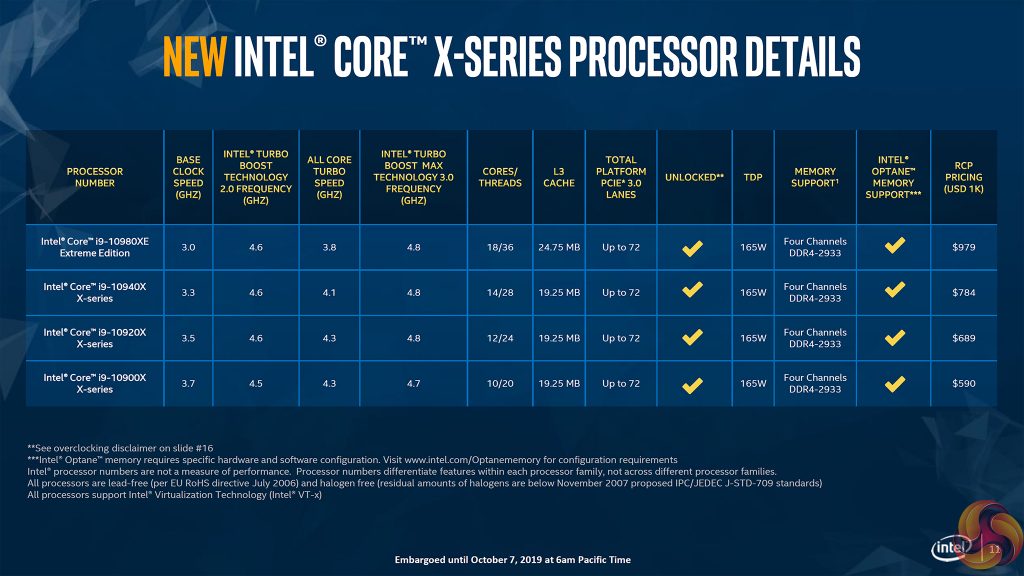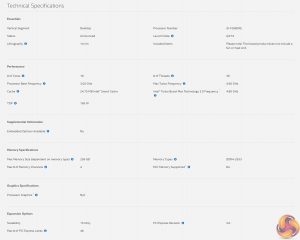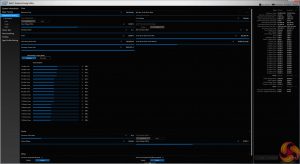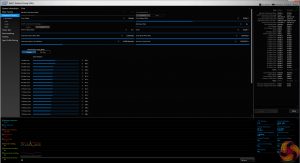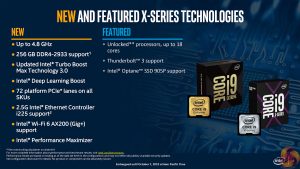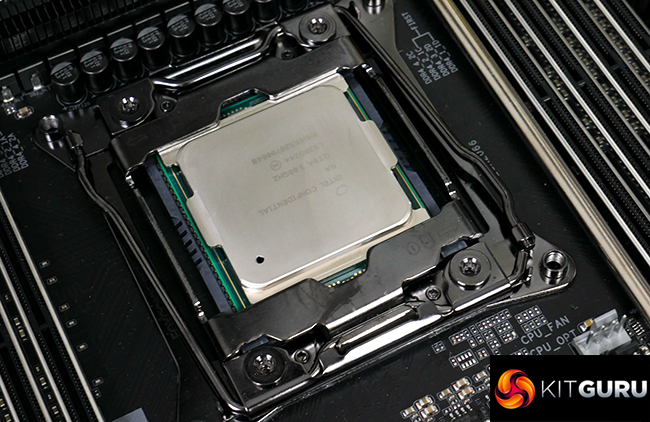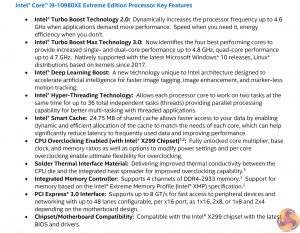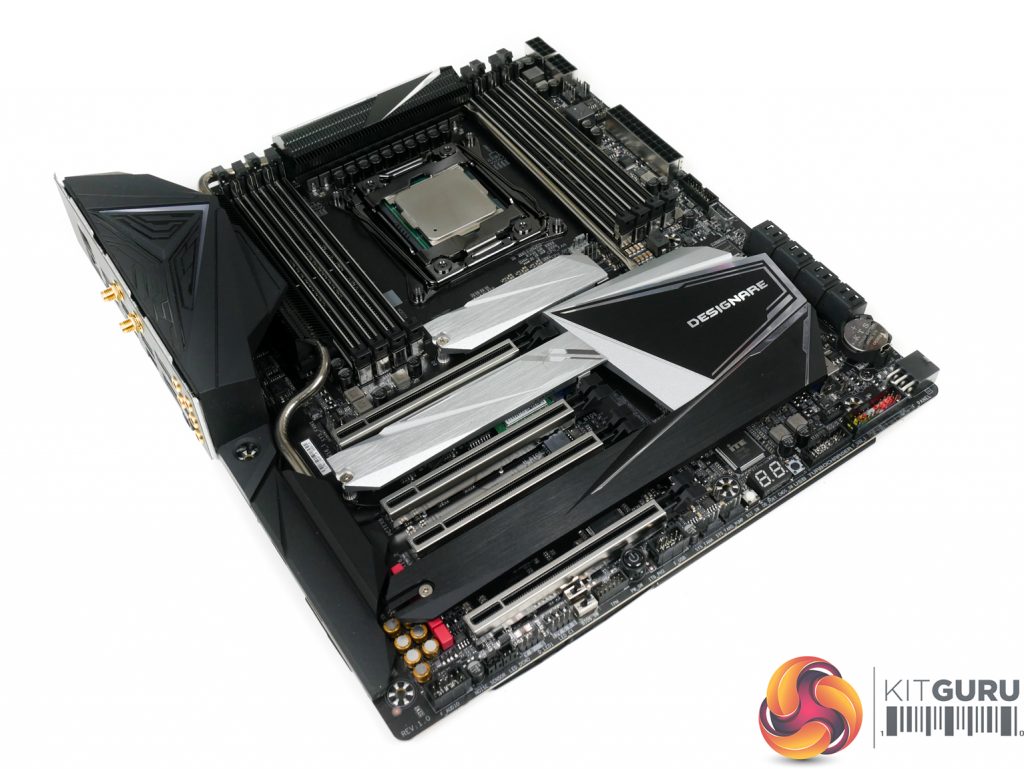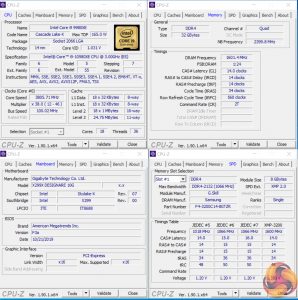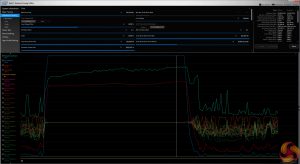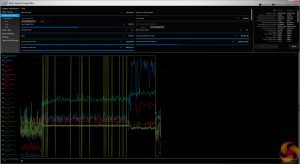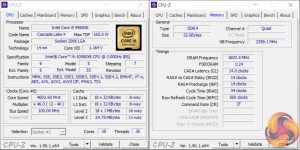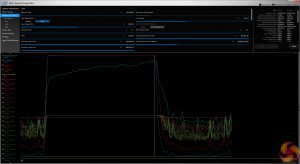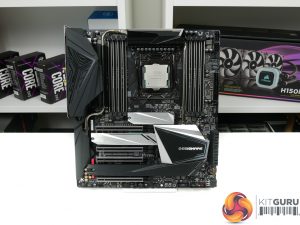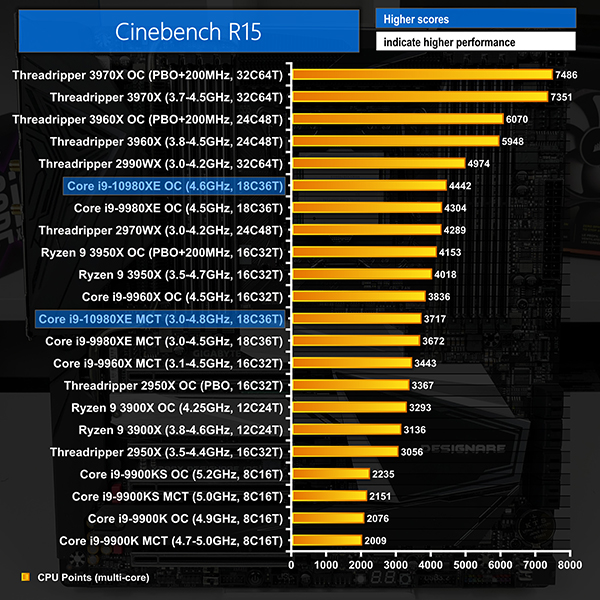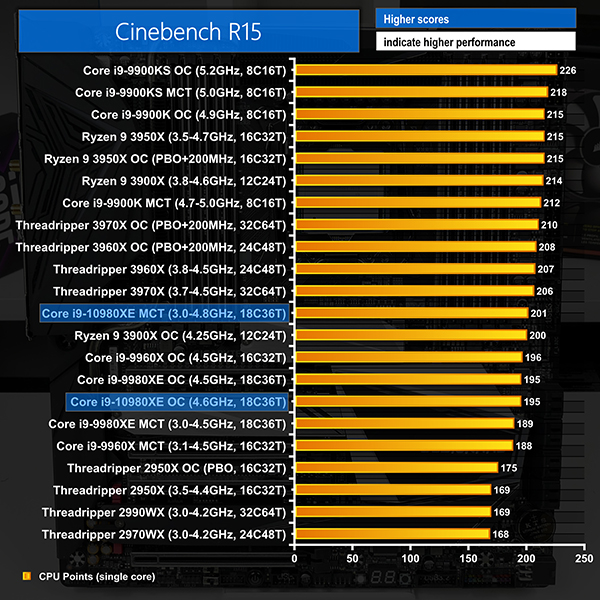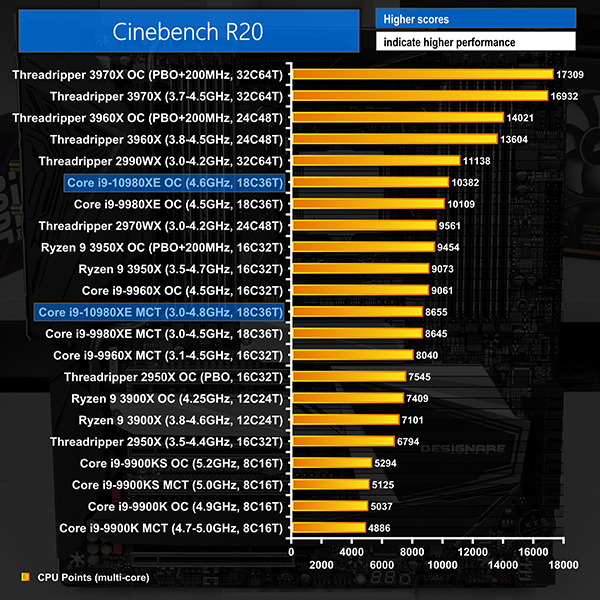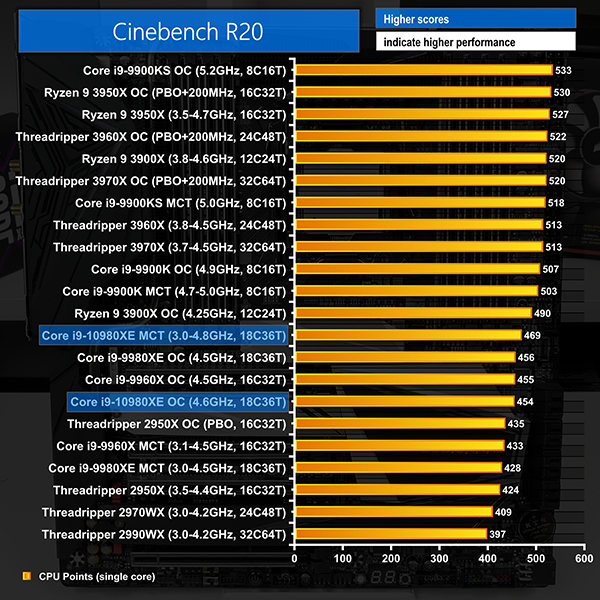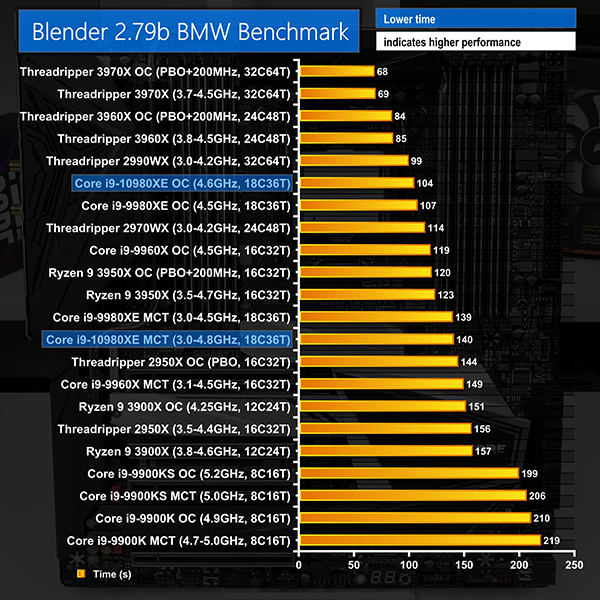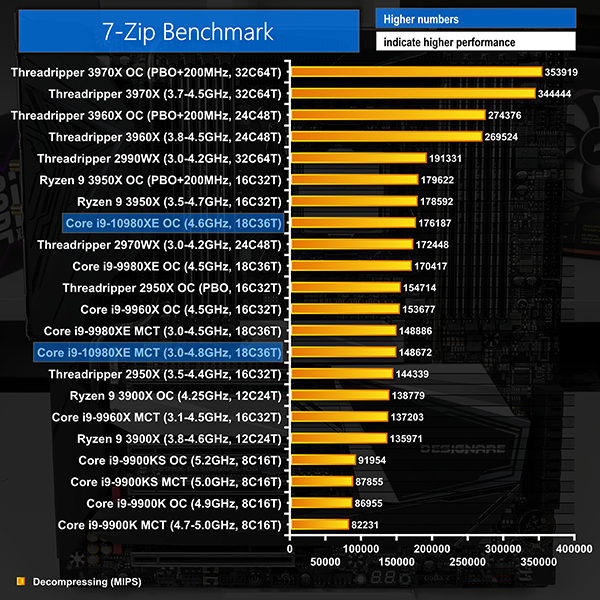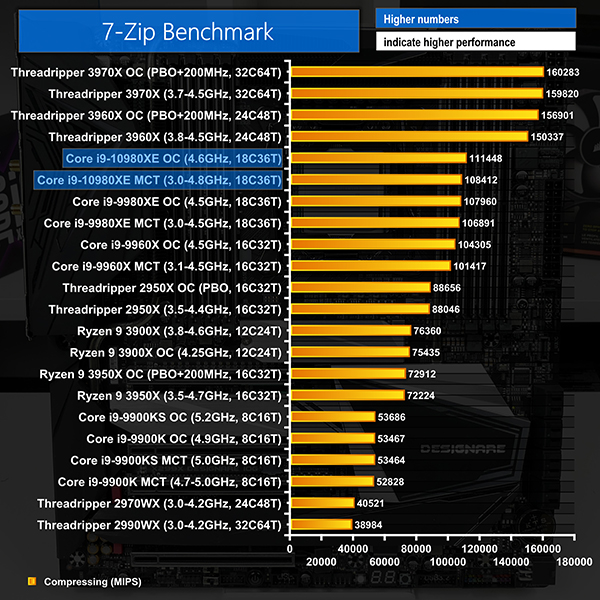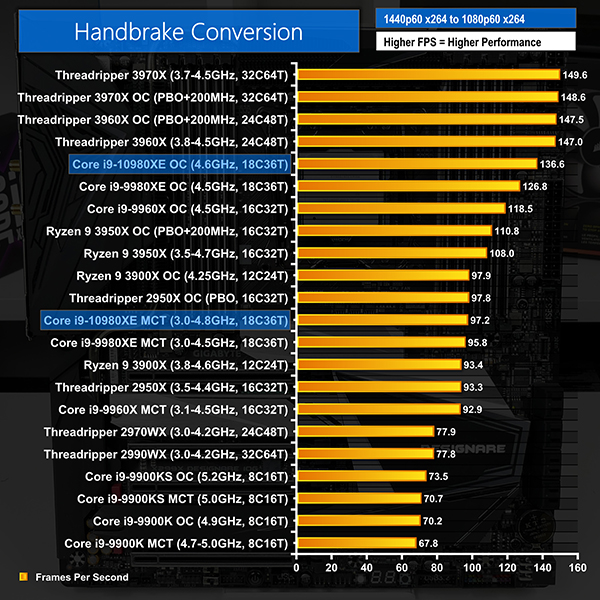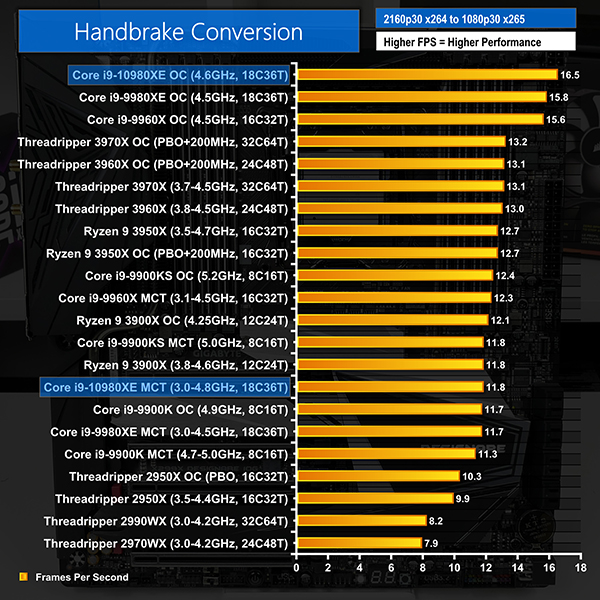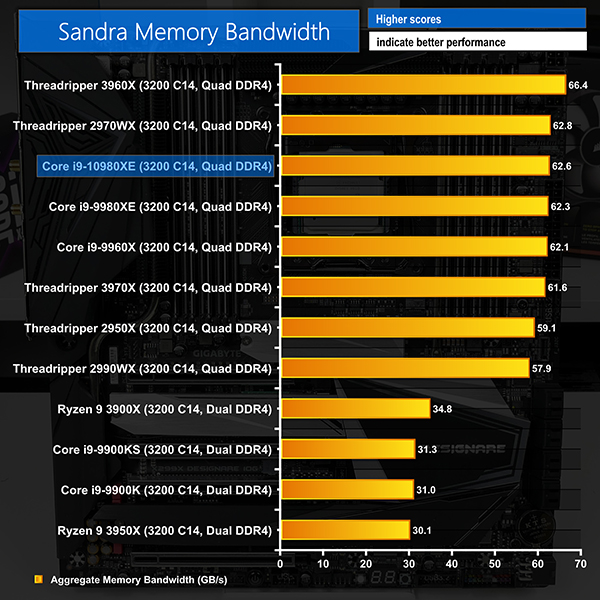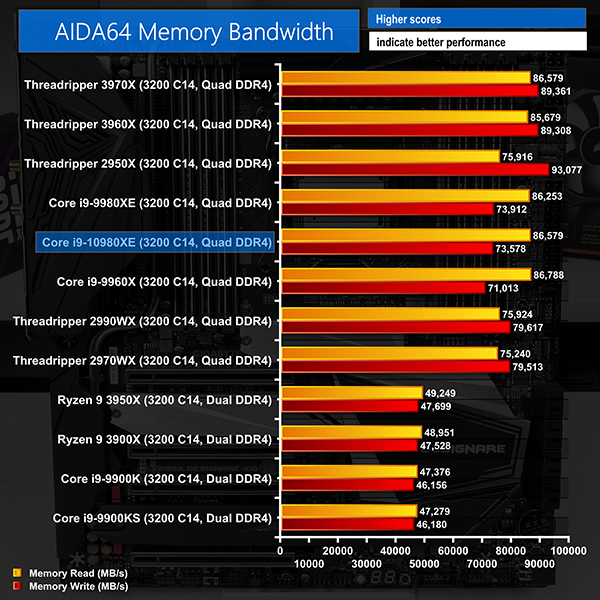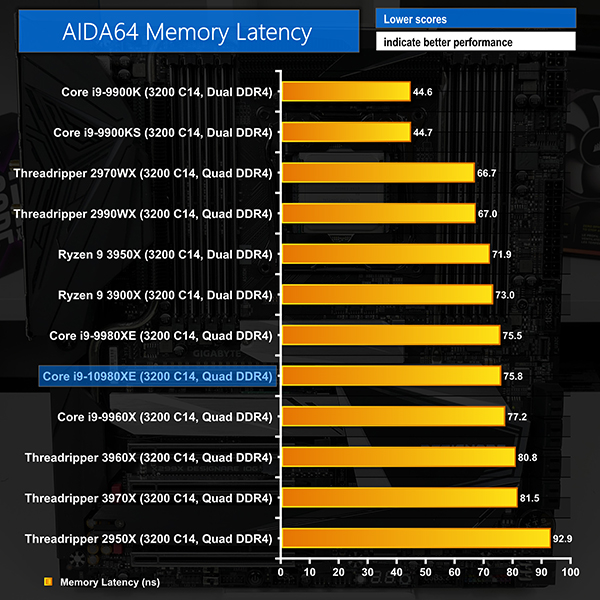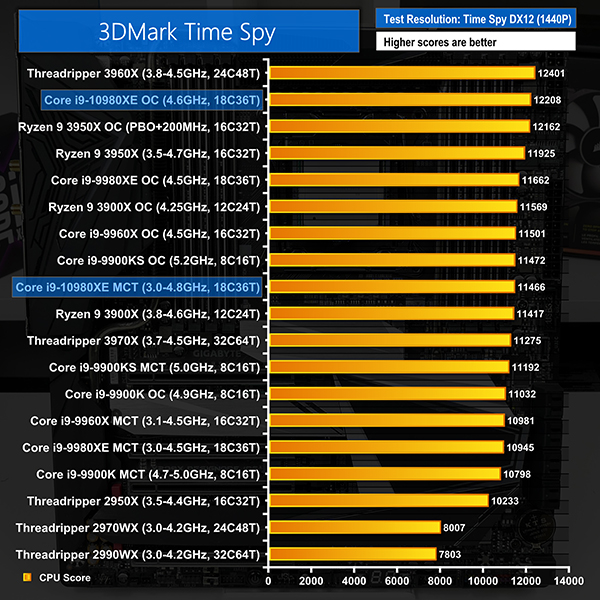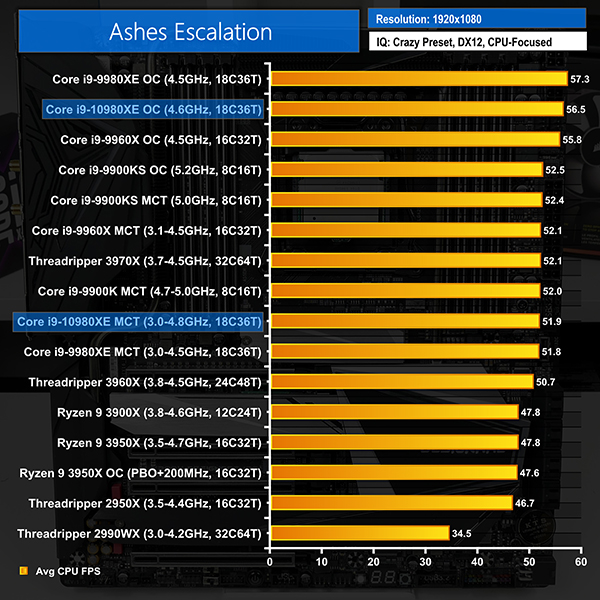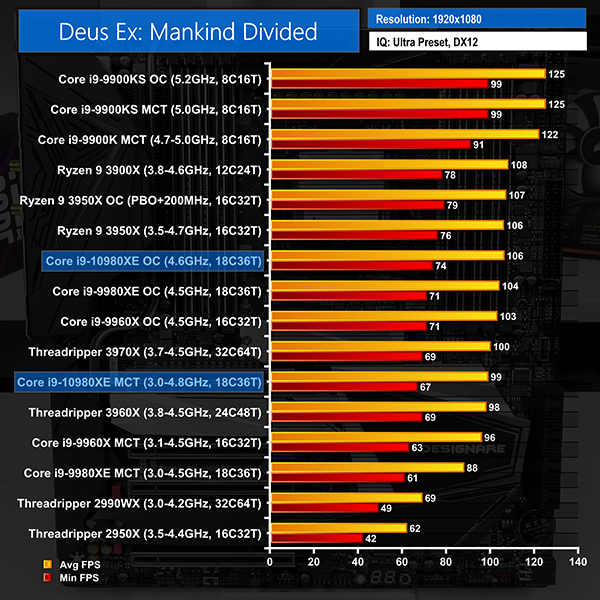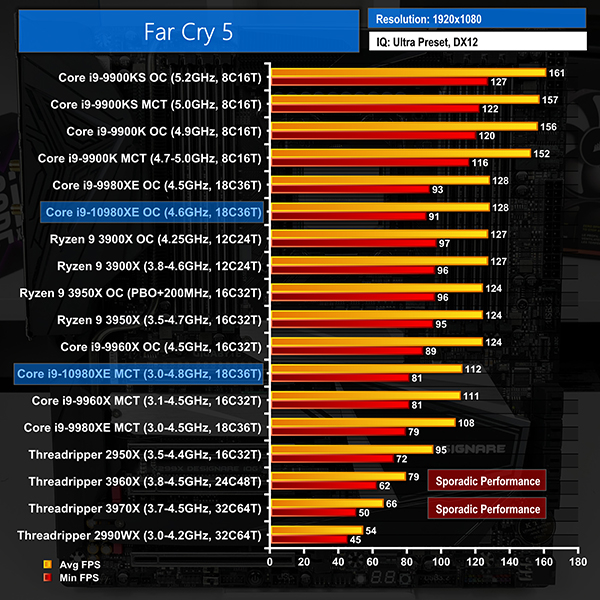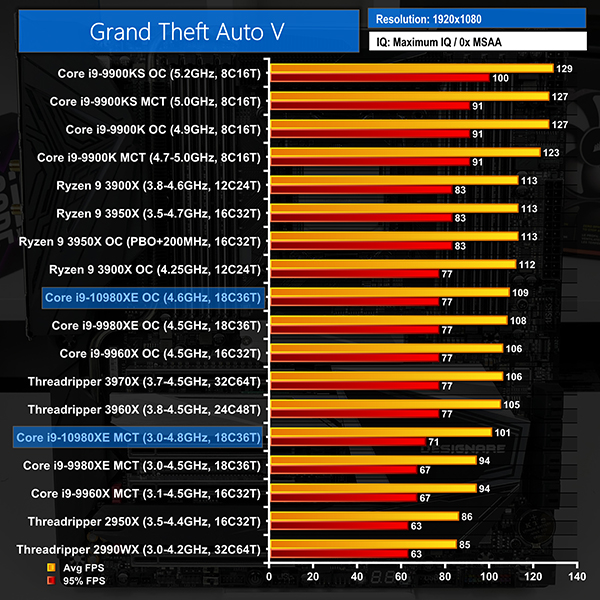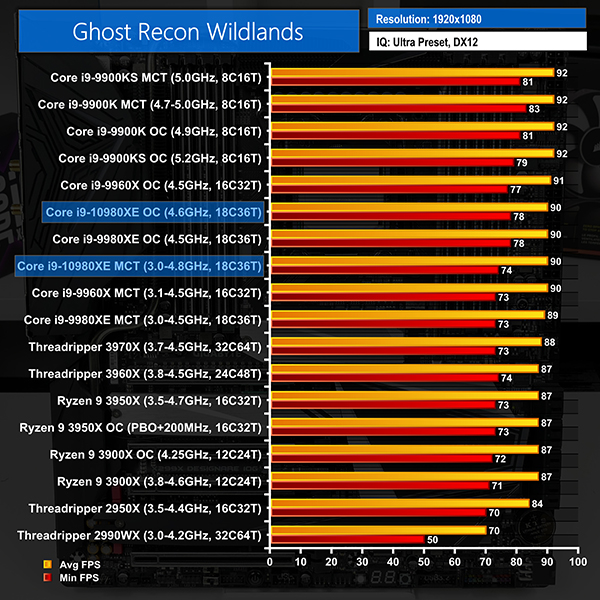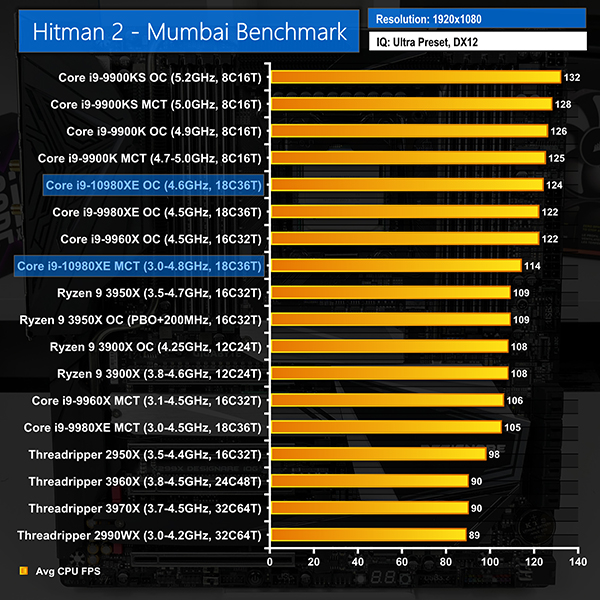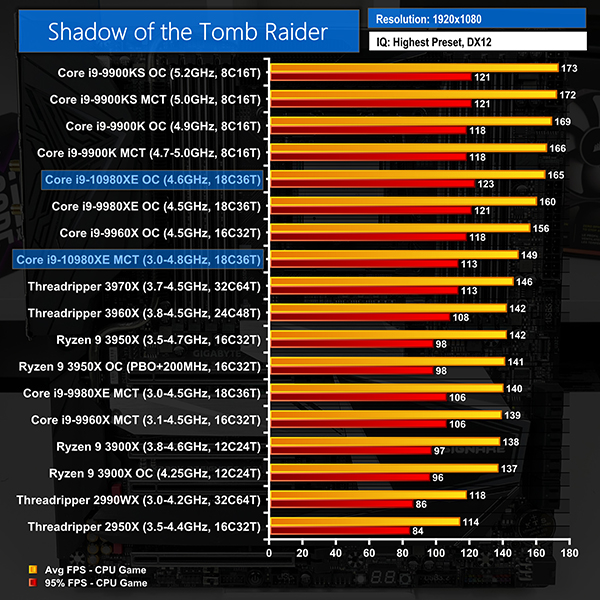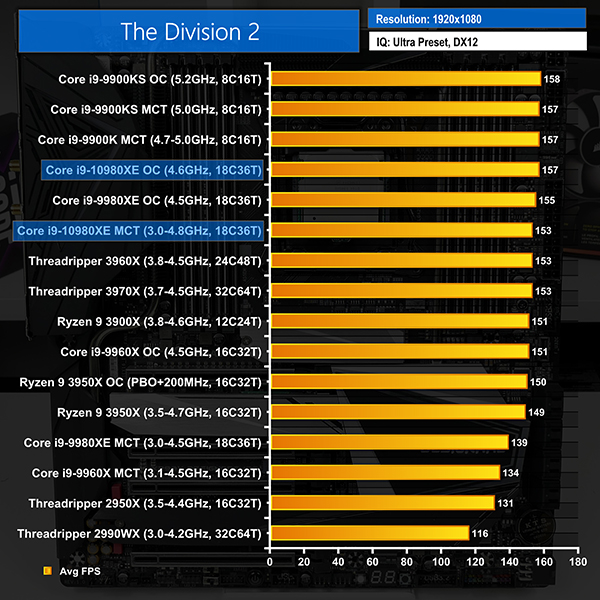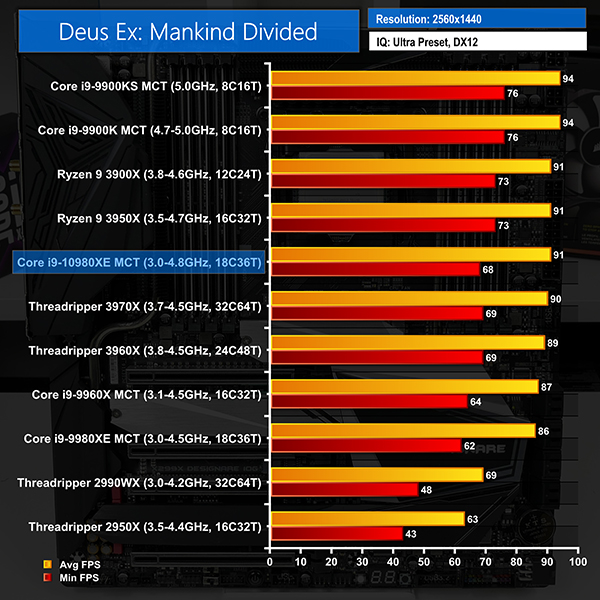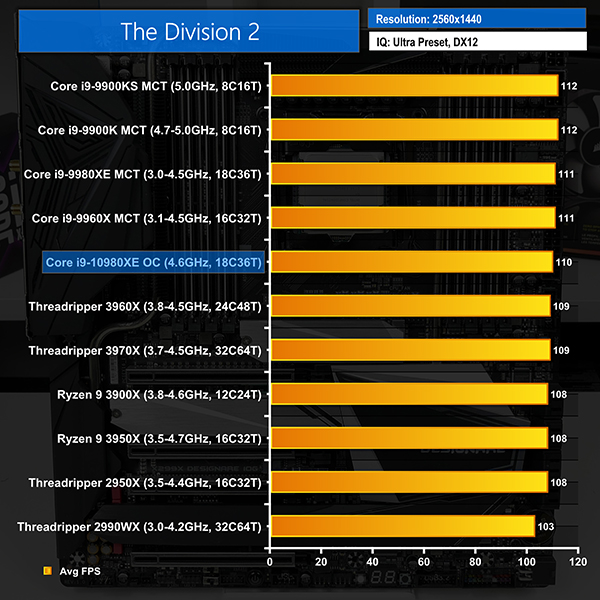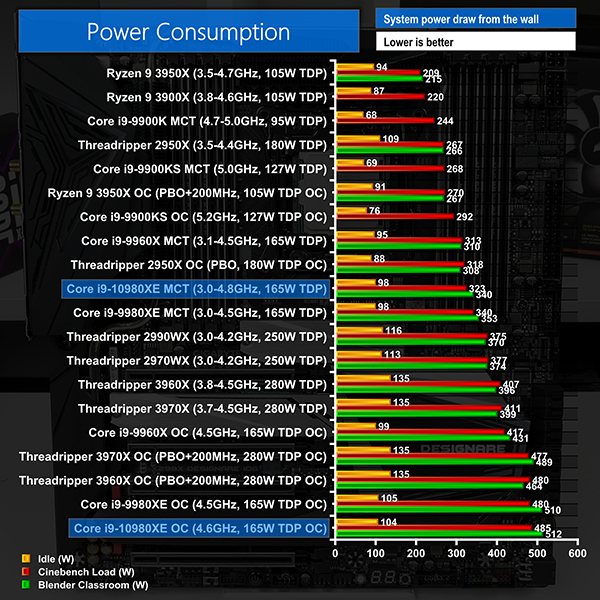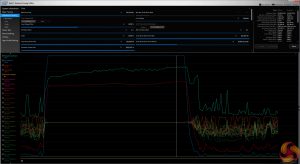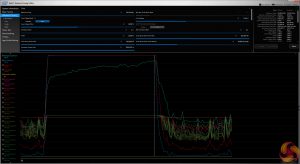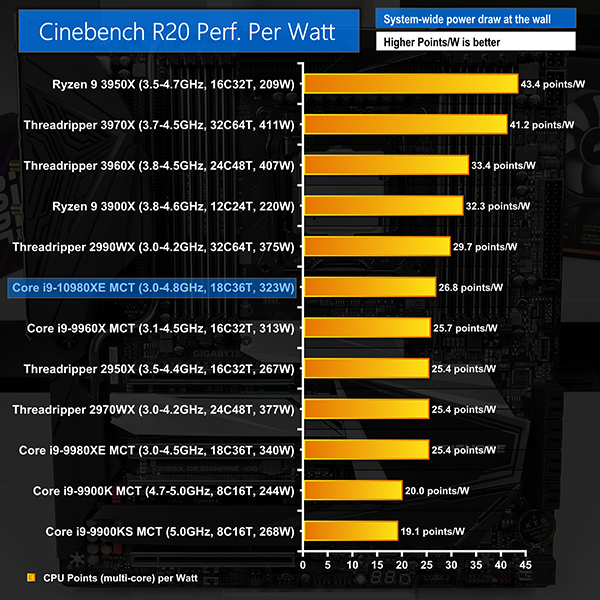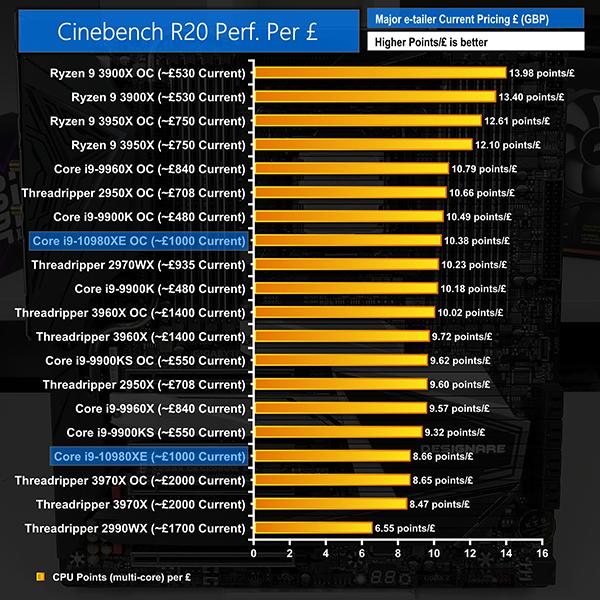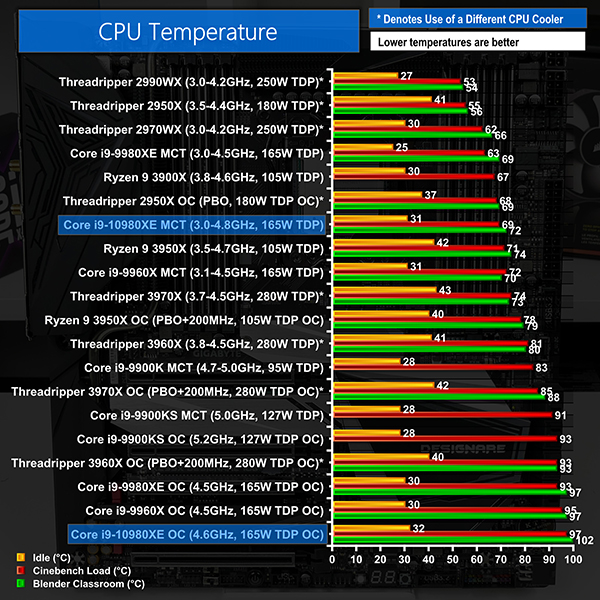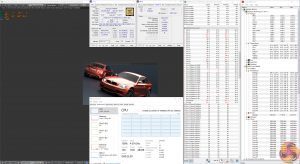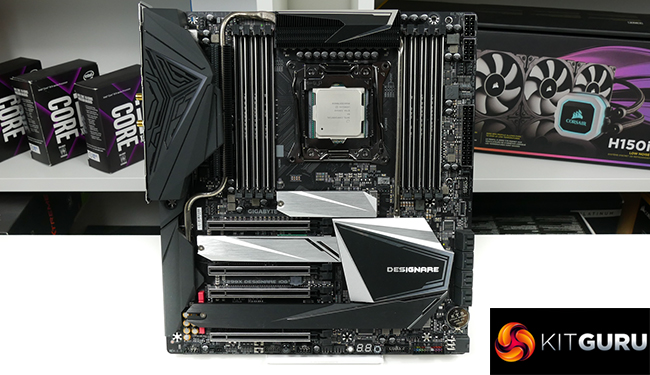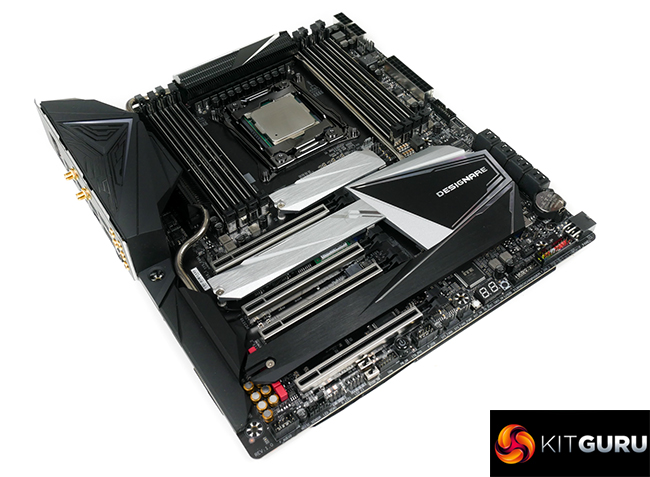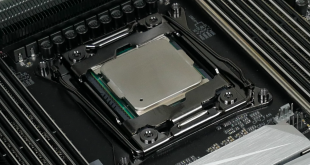
Intel’s new Cascade Lake-X processors have launched for the X299 HEDT platform, with the new flagship Core i9-10980XE featuring a huge price reduction to $979 MSRP. That $1000 trimming of the ticket price places Intel's new HEDT line-up in a far stronger position to compete against AMD's Ryzen and Threadripper offerings.
Fundamentally, the Cascade Lake-X chips are slight revisions of their Skylake-X 9000-series predecessors (which in themselves were slight revisions of the Skylake-X 7000-series processors). They slot into the same LGA 2066 socket and are compatible with existing X299 motherboards with a BIOS update.
The flagship Core i9-10980XE features 18 cores and 36 threads built on Intel's revised 14nm process technology. Say what you want about Intel’s struggles with 10nm, but the company’s ability to keep pushing and refining 14nm is really impressive given how competitive TSMC’s 7nm node is. Intel still maintains a frequency advantage versus TSMC 7nm, but power efficiency is far better for the smaller process used by Zen 2.
The base clock is 3.0GHz with a maximum Turbo Boost Max 3.0 frequency of 4.8GHz, Turbo Boost 2 frequency of 4.6GHz, and an all-core frequency of 3.8GHz. It is important to note that the frequencies may be reduced under heavy AVX operations as such workloads can eat more greedily into the power budget that Intel uses to control boost frequencies.
The official TDP figure is still 165W for the flagship, even though most X299 motherboards will blatantly ignore this when settings such as XMP are applied.
Cache capacity comes in at 24.75MB of Intel Smart Cache, you get AVX-512 support with 2 FMA units, quad-channel memory is still available, and there's support for Intel Optane memory, if that's important to you.
If you’re thinking that those specs sound familiar, it’s because they are. Intel’s ‘new’ Core i9-10980XE is a slightly tweaked version of the current i9-9980XE. To keep things simple, we will highlight the main differences between the two 18-core parts.
The new Core i9-10980XE features higher maximum boost frequencies than its predecessor. Turbo Boost Max 3.0 is up to 4.8GHz versus 4.5GHz for 9980XE and Turbo Boost 2 is now 4.6GHz versus 4.4GHz for the older chip.
Digging into XTU under our own usage, we can see that the frequency uplift for Intel’s 10980XE (screenshot on the left) will be especially predominant versus the 9980XE (screenshot on the right) when 1 and 2 cores or 3 and 4 cores are loaded. Once you go beyond loading 12 cores, the operating frequencies, according to our XTU data, are identical.
As a note, up to 4 cores at 4.7GHz is certainly an impressive operating frequency for this level of processor. You get high lightly-threaded frequencies and scalability for heavily multi threaded workloads.
There's now support for 256GB of DDR4 memory, thanks to new 32GB DIMMs coming to market. Though, unlike Threadripper, Intel still does not offer ECC for its Core i9 chips, which we don't feel the need to complain about.
Official memory frequency support is improved to DDR4-2933MHz in 1 DPC mode and DDR4-2666MHz in 2 DPC mode. No doubt, X299 motherboards will support higher, as they did with 7000-series and 9000-series processors. We ran 3200MHz XMP in 1 DPC mode without problems. This official bump is more important for OEM system vendors like Dell and HP, though.
You now get 48 PCIe Gen 3 lanes from the CPU, up from 44 lanes for the 9980XE. That’s in addition to the up to 24 PCIe Gen 3 lanes for the X299 chipset, though they connect via a very limited DMI 3.0 interface (which is effectively a PCIe 3.0 x4 connection). An extra 4 lanes is certainly a nice value add, but AMD’s competing TRX40 HEDT platform is far more bandwidth generous by offering PCIe Gen 4 support and a fatter pipe to the chipset.
One of the key differences is support for Intel Deep Learning Boost, or DL Boost for short. Intel pushes this AVX-512-based feature set for workloads such as AI image inference. Though software packages that take advantage of DL Boost are currently scarce, it’s certainly a feature that’s worth paying attention to if you plan to work with AI inference-type projects in the future.
The i9-10980XE's Tjmax is now 86C versus 84C for 9980XE. The older 7980XE was higher at 94C, which made it good for pushing hard overclocks, especially when de-lidded. Thankfully, Intel gives the Cascade Lake-X flagship a heatspreader that is soldered.
Also worth noting is support for Intel's Performance Maximizer overclocking tool, in addition to security mitigations that are baked into Cascade Lake processors.
Most importantly, though, is the massive $1000 price reduction for the Core i9-10980XE versus the Core i9-9980XE it replaces. This is a big deal as it now makes the flagship 18-core reasonably affordable, plus it gives a good upgrade path for early X299 adopters on the 10-core 7900X who may have otherwise been tempted by Threadripper 3000.
Intel’s new pricing puts the flagship nicely in the rather large void left by AMD’s Zen 2 line-up between $749 and $1399. It will be interesting to see if Intel enjoys a performance lead versus the older Threadripper parts that AMD expects to fill the void.
Our objective with CPU overclocking is to hit frequencies that we think will be achievable for daily use by the platform’s buyers. As such, we test with sensible cooling hardware in the Corsair H100X 240mm AIO CPU cooler. We also aim to use sensible voltages that lead to manageable thermal results.
Stability is confirmed by running multiple Cinebench tests, Handbrake video conversion, and extended Blender rendering runs. We do not use Prime95 as we have found it to be overly demanding as a stress test application with the more recent AVX-capable versions.
The partnering hardware of choice is the Gigabyte X299X Designare 10G motherboard, 32GB of 3200MHz CL14 DDR4, and a Seasonic Prime 1000W Titanium PSU.
Stock Frequencies:
As we showed for our XTU screenshots, the all-core frequency of the Core i9-10980XE is 3.8GHz. The exception there is with AVX workloads whereby a frequency reduction is applied to compensate for the increased power demand of the advanced instruction set.
We saw 3225MHz as the averaged all-core frequency for our Handbrake x264 test (which uses around 85-95% of the CPU compute capability). The Handbrake x265 test ran at 3.45-3.55GHz on average with the overall CPU utilisation being around 35-45%. Blender also dropped to around 3.3-3.4GHz in our BMW testing, while Cinebench R20 remained largely unaffected by an AVX-induced clock reduction, surprisingly.
Overclocked Frequencies:
Overclocking was rather challenging due to the high heat output from the 18-core processor. We finally settled on a 1.165V load voltage according to CPU-Z. This was stable at 4.6GHz across our test suite and for extended Blender runs.
This is an exceptional result for a processor with this many cores and reasonable cooling that is 24/7 usable.
Temperatures hovered just above 100°C for the CPU package though the cores were generally around 10°C lower at low-to-mid-90s. We didn’t experience any thermal throttling, so we were happy to proceed, despite this being a somewhat worryingly high temperature level for our overclock.
To run this level of overclock, you’ll need high performance CPU cooling and also a strong motherboard VRM like the one on our Gigabyte X299X Designare 10G motherboard. We recorded the software-read CPU package power at 330W in Blender, which is a large amount of power to shift through the VRM. Thankfully, this Gigabyte board uses an excellent finned VRM heatsink. Many older X299 motherboards had poor VRM cooling, so keep a close eye on MOSFET temperatures if you plan to heavily overclock the i9-10980XE.
To confirm, our overclock result was 4.6GHz at 1.165V load voltage with no AVX offset. This was 100MHz higher than what our Core i9-9980XE achieved, with 10mV lower voltage. Not a bad result at all, especially when you factor in just how impressive 4.6GHz across 18 cores is. Intel’s high frequency capability really is praiseworthy with the refined 14nm process node.
We will be outlining the Intel Core i9-10980XE CPU's performance while using the Gigabyte X299X Designare 10G motherboard. A 32GB (4x8GB) kit of 3200MHz CL14 DDR4 memory serves our test system.
Today's comparison processors come in the form of:
- Coffee Lake Core i9-9900K (8C16T) and Core i9-9900KS (8C16T).
- Skylake-X Core i9-9960X (16C32T) and Core i9-9980XE (18C36T).
- Matisse ‘Zen 2' Ryzen 9 3900X (12C24T) and Ryzen 9 3950X (16C32T).
- Zen+ Ryzen Threadripper 2950X (16C32T), Ryzen Threadripper 2970WX (24C48T), and Ryzen Threadripper 2990WX (32C64T).
- Zen 2 Ryzen Threadripper 3960X (24C48T) and Ryzen Threadripper (32C64T).
Each processor is tested at its default out-of-the-box settings. We also include reasonable overclocking performance data where relevant.
For the Intel CPUs, forced turbo is enabled by default when XMP is enabled and, in most scenarios, cannot be disabled. As such, we test using the forced turbo frequencies with the Intel processors.
All-core load frequencies for the tested chips are as follows:
- Core i9-9900KS = 5.0GHz.
- Core i9-9900K = 4.7GHz.
- Core i9-9980XE = 3.8GHz (without AVX2/AVX-512 reductions).
- Core i9-9960X = 4.0GHz (without AVX2/AVX-512 reductions).
- Core i9-10980XE = 3.8GHz (without AVX2/AVX-512 reductions).
- Ryzen Threadripper 2950X = Around 3550-3600MHz.
- Ryzen Threadripper 2970WX = Around 3350-3400MHz.
- Ryzen Threadripper 2990WX = Around 2975-3100MHz.
- Ryzen Threadripper 3960X = Around 4025MHz.
- Ryzen Threadripper 3970X = Around 3850-3900MHz.
- Ryzen 9 3900X = Around 4050MHz (AGESA 1.0.0.3ABBA).
- Ryzen 9 3950X = Around 3800-3950MHz (AGESA 1.0.0.4).
CPU Test System Common Components:
- Graphics Card: Gigabyte Aorus RTX 2080 Ti XTREME (custom fan curve to minimise thermal throttling).
- Memory: 16GB (2x8GB) G.Skill 3200MHz 14-14-14-34 DDR4 @ 1.35V (4x8GB for quad-channel systems).
- CPU Cooler: Corsair H100X with 2435 RPM SP120L fans (Cooler Master Wraith Ripper for Threadripper platforms).
- Games SSD: Aorus 2TB PCIe Gen 4 M.2 SSD & Crucial MX300 750GB SATA SSD.
- Power Supply: Seasonic Prime Titanium 1000W.
- Operating System: Windows 10 Pro 64-bit 1903 Update.
LGA 2066 System (i9-9960X, i9-9980XE, i9-10980XE):
- Core i9-10980XE CPU: Intel Core i9-10980XE ‘Cascade Lake-X' 18 cores, 36 threads (4.6GHz @ 1.165V overclocked).
- Core i9-9960X CPU: Intel Core i9-9960X ‘Skylake-X' 16 cores, 32 threads (4.5GHz @ 1.2V overclocked).
- Core i9-9980XE CPU: Intel Core i9-9980XE ‘Skylake-X' 18 cores, 36 threads (4.5GHz @ 1.175V overclocked).
- Motherboard: Gigabyte X299X Designare 10G (LGA 2066, X299, F3a BIOS).
- System Drive: Corsair Neutron XT 480GB SATA SSD.
sTRX4 System (Ryzen Threadripper 3960X, Ryzen Threadripper 3970X):
- Ryzen Threadripper 3970X CPU: AMD Ryzen Threadripper 3970X ‘Castle Peak' 32 cores, 64 threads (PBO+200MHz overclocked).
- Ryzen Threadripper 3960X CPU: AMD Ryzen Threadripper 3960X ‘Castle Peak' 24 cores, 48 threads (PBO+200MHz overclocked).
- Motherboard: ASUS ROG Zenith Extreme II (sTRX4, TRX40, 0601 BIOS, AMD AGESA CastlePeakPI-SP3r3-1.0.0.2).
- System Drive: ADATA SX8200 480GB PCIe NVMe SSD.
- CPU Cooler: Cooler Master Wraith Ripper.
LGA 1151 Rev. 2 System (i9-9900K, i9-9900KS):
- Core i9-9900K CPU: Intel Core i9-9900K ‘Coffee Lake' 8 cores, 16 threads (4.9GHz @ 1.3V overclocked).
- Core i9-9900KS CPU: Intel Core i9-9900KS ‘Coffee Lake' 8 cores, 16 threads (5.2GHz @ 1.375V overclocked).
- Motherboard: Gigabyte Z390 Aorus XTREME (LGA 1151 rev. 2, Z390, F7 BIOS).
- System Drive: Plextor M9Pe 512GB PCIe NVMe SSD.
AM4 System (Ryzen 9 3900X, Ryzen 9 3950X):
- Ryzen 9 3900X CPU: AMD Ryzen 9 3900X ‘Matisse' 12 cores, 24 threads (4.25GHz @ 1.35-1.4V overclocked).
- Ryzen 9 3950X CPU: AMD Ryzen 9 3950X ‘Matisse' 16 cores, 32 threads (PBO+200MHz overclocked).
- Motherboard: Gigabyte X570 Aorus Master (AM4, X570, F10a BIOS, AMD AGESA Combo-AM4 1.0.0.4).
- System Drive: WD Black SN750 500GB PCIe NVMe SSD.
TR4 System (Ryzen Threadripper 2950X, Ryzen Threadripper 2970WX, Ryzen Threadripper 2990WX,):
- Ryzen Threadripper 2990WX CPU: AMD Ryzen Threadripper 2990WX ‘Colfax' 32 cores, 64 threads.
- Ryzen Threadripper 2970WX CPU: AMD Ryzen Threadripper 2970WX ‘Colfax' 24 cores, 48 threads.
- Ryzen Threadripper 2950X CPU: AMD Ryzen Threadripper 2950X ‘Colfax' 16 cores, 32 threads (PBO overclocked).
- Motherboard: Gigabyte X399 Gaming 7 (TR4, X399, F12h BIOS, AMD AGESA SummitPI-SP3r2-1.1.0.2).
- System Drive: ADATA XPG SX950 240GB SATA SSD.
- CPU Cooler: Cooler Master Wraith Ripper.
Software:
- GeForce 440.97 VGA drivers.
Tests:
Productivity-related:
- Cinebench R15 – All-core & single-core CPU benchmark (CPU)
- Cinebench R20 – All-core & single-core CPU benchmark (CPU)
- Blender 2.79b – All-core rendering of the BMW benchmark (CPU)
- HandBrake x264 – Convert 1440p60 H264 video to 1080p60 H264 using the YouTube HQ 1080p60 preset (CPU & Memory)
- HandBrake x265 – Convert 4K30 100Mbps H264 video to 1080p30 40Mbps H265 using the H.265 MKV 1080p30 preset (CPU & Memory)
- 7-Zip – Built-in 7-Zip benchmark test (CPU & Memory)
- SiSoft Sandra – Memory bandwidth and Cache & Memory Latency Test (Memory)
- AIDA64 – Memory bandwidth, memory latency, memory & cache latency (Memory)
Gaming-related:
- 3DMark Time Spy – Time Spy (DX12) test (Gaming)
- Ashes Escalation – Built-in benchmark tool, 1920 x 1080, Crazy quality preset, CPU-Focused Test, DX12 (Gaming)
- Deus Ex: Mankind Divided – Built-in benchmark tool, 1920 x 1080, Ultra quality preset, no AA, DX12 version (Gaming)
- Far Cry 5 – Built-in benchmark tool, 1920 x 1080, Ultra quality preset, DX12 (Gaming)
- Ghost Recon: Wildlands – Built-in benchmark tool, 1920 x 1080, Ultra quality preset, DX12 (Gaming)
- Grand Theft Auto V – Built-in benchmark tool, 1920 x 1080, Maximum quality settings, Maximum Advanced Graphics, DX11 (Gaming)
- Hitman 2 – Built-in benchmark tool – Mumbai scene, 1920 x 1080, Ultra quality preset, DX12 (Gaming)
- Shadow of the Tomb Raider – Built-in benchmark tool, 1920 x 1080, Highest quality preset, no AA, DX12 version (Gaming)
- The Division 2 – Built-in benchmark tool, 1920 x 1080, Ultra quality preset, no AA, DX12 version (Gaming)
Cinebench R15
Starting with Cinebench R15 multi-threaded, the similarities between the 10980XE and the 9980XE it replaces are clear to see. Intel’s roughly £1000 HEDT flagship has a tough time hanging with the similarly priced Threadripper 2970WX, with AMD’s last-gen chip offering 15% higher performance stock versus stock. Even worse for Intel, the $749 Ryzen 9 3950X also offers higher performance out of the box.
Overclocking is where Intel’s chip shines, with the speed bump to 4.6GHz delivering 20% extra performance, now putting the 10980XE faster than the stock-clocked Threadripper 2970WX and the PBO overclocked 3950X.
Compared to AMD’s new Ryzen Threadripper 3000 chips, Intel cannot really compete in this test. At stock clocks, AMD’s $1400 24-core 3960X is 60% faster and the 32-core 3970X offers nearly double the performance, albeit at double the price.
Cinebench R20
Despite the longer run time and more demanding workload for Cinebench R20, the same performance trends are observed. The 9980XE and 10980XE are basically identical as they both share a 3.8GHz all-core frequency, provided AVX limits aren’t hit. Last-gen Threadripper 2970WX is faster than the Core i9-10980XE by 10%, while the cheaper Ryzen 9 3950X is 5% faster.
Leveraging Intel’s heavy frequency headroom puts the Core i9-10980XE above stock-clocked Threadripper 2970WX by 9%. Intel’s OC versus OC performance lead against Ryzen 9 3950X is 10%, albeit with a $230 price premium.
Once again, AMD’s more expensive Threadripper 3000 series HEDT parts are at a completely different performance level to Intel’s HEDT Core i9 flagship.
A higher maximum boost clock versus the older 18-core HEDT flagship delivers a strong performance uplift for the 10980XE in the Cinebench 1T test. Versus AMD’s last gen Threadripper chips, Intel’s single-threaded performance lead is mighty, even when the 18-core’s top-end frequency is reduced in favour of an all-core overclock.
With that said, Intel’s Cascade Lake-X is outperformed by the Ryzen Threadripper 3000 processors and the cheaper Ryzen 9 3950X. Versus AMD’s Zen 2 parts, it is clear that Intel’s historic single-threaded performance lead in applications such as Cinebench has been eroded.
Blender BMW Benchmark
Next, we will look at Blender performance. Bear in mind that a render time reduction of 50% mathematically converts into a performance increase of 100% as you can get twice the work done in the same period of time. Put another way, a chip that requires 70 seconds to complete the render can do twice as much work (100% more) than a chip that takes 140 seconds to complete the render.
Yet again, we see basically identical performance between the Core i9-10980XE and its i9-9980XE predecessor in Blender. AMD’s Threadripper 2970WX is 19% quicker to complete the render, which converts into 23% higher performance. The lower-cost Ryzen 9 3950X finishes 17 seconds or 12% faster than the Cascade Lake-X flagship, which translates into 14% higher performance for AMD’s mainstream chip. Once again, the more expensive Threadripper 3000 HEDT chips from AMD are at a completely different performance level, with the 32-core 3970X flagship actually offering more than double the stock 10980XE’s performance.
Overclocking is yet again Intel’s saviour, with the 4.6GHz 18-core outperforming both of the price comparable AMD parts by a comfortable margin and getting to within 5% of AMD’s 32-core Threadripper 2990WX performance.
7-Zip
In 7-Zip’s decompression test, we, yet again, see that performance of the 10980XE is basically identical to the 9980XE. AMD’s cheaper Ryzen 9 3950X and Ryzen Threadripper 2970WX both deliver commanding victories versus the Intel HEDT flagship as AMD’s Zen architecture is particularly strong for this decompression workload. Even a heavy overclock to 4.6GHz only allows Intel's best Core i9 to roughly keep pace with AMD’s cheaper contenders.
Looking at Cascade Lake-X versus Threadripper 3000, the 40% more expensive AMD 3960X 24-core chip is 81% faster stock versus stock and 56% better OC versus OC.
Memory bandwidth and accessibility play more important roles in the 7-Zip compression test and this allows the Core i9-10980XE to comfortably outperform AMD’s dual-channel Ryzen 9 3950X in addition to the Threadripper 2970WX with its unique memory system. Even the 16-core, quad-channel Ryzen Threadripper 2950X is outgunned by Intel’s Cascade Lake-X flagship to the tune of 23%.
This is a strong result for Intel’s new HEDT flagship, though the benefit of those 18 cores are somewhat questionable, given the proximity of the 16-core i9-9960X’s performance. That’s the same story for Threadripper 3000 which, as it happens, offers significantly higher performance than Intel’s more affordable HEDT chips.
Handbrake
Handbrake struggles to saturate 100% of the CPU resources on these high core count chips, so operating frequency becomes even more important. The Core i9-10980XE is a smidgen faster than the Core i9-9980XE as the newer chip is more able to sustain higher frequencies in light of the AVX offset trigger in this workload. AMD’s cheaper Threadripper 2950X needs a PBO overclock to outperform the stock 10980XE, while memory accessibility issues for the 2970WX mean Intel’s stock Core i9 flagship is 25% faster.
The $749 Ryzen 9 3950X puts in a strong fight against the more costly Cascade Lake-X chip, with AMD’s mainstream part offering 11% higher performance. Throw overclocking into the mix and the strong frequency capability from Intel's 14nm chip and the removal of AVX speed reductions delivers a large performance boost that is only bested by Threadripper 3000. Clearly, our Handbrake x264 conversion test loves frequency in addition to many cores, and Intel’s HEDT flagship delivers well on that front.
Resource utilisation on high core count CPUs is even lower for our Handbrake x265 test. Intel’s Core i9-10980XE is, again, almost identical to the i9-9980XE it replaces. Compared to Ryzen 9 3950X, AMD’s $749 chip is faster than Intel’s $979 one thanks to higher sustained frequencies. Intel does, however, manage to comfortably outperform the Threadripper 2970WX and its awkward memory configuration with the 10980XE.
Overclocking is where the Intel HEDT chips really shine, and Intel’s new Cascade Lake-X flagship shoots straight to the top of our chart at 4.6GHz. Even AMD’s hefty Threadripper 3000 parts cannot keep pace with the 4.5GHz-plus Intel HEDT chips. If you only want to do single video conversion with Handbrake x265, the Core i9-10980XE is a performance leader when overclocked and still has ample CPU resources spare for reasonable background multi-tasking.
Sandra Memory Bandwidth
Quad-channel DDR4 and solid high-frequency support through X299 motherboards delivers good memory bandwidth performance for Intel’s HEDT part. The official speed bump to 2933MHz in 1 DPC mode is good to see, though if you’re using higher-speed XMP kits with an X299 motherboard, you won’t see any bandwidth increases versus the older 16- or 18-core processors.
While Ryzen 9 3950X was generally very competitive against the more expensive Core i9-10980XE, quad-channel memory support is one of those features that Intel is clearly charging extra for and it’s one that can pay dividends if you have workloads that demand memory bandwidth.
AIDA64 Memory Performance
Memory latency is also similar for Cascade Lake-X versus Skylake-X. The Core i9-10980XE is better than Threadripper 3000 and the 2-die Threadripper 2950X in our AIDA latency test, but the result is comparable to mainstream Ryzen and is slightly worse than older quad-die Threadripper chips.
Intel’s mainstream Coffee Lake chips do not use the HEDT mesh architecture under-the-hood and therefore offer significantly better memory latency performance in our AIDA-based testing. This is important to bear in mind for latency-sensitive situations, one of which is gaming.
3DMark
Ashes Escalation
Ashes of the Singularity Escalation is a well multi-threaded DX12 title that features a CPU-focused benchmark test. We use the game's built-in benchmark with quality set to Crazy.
Deus Ex: Mankind Divided
Despite its age, Deus Ex: Mankind Divided remains a demanding title even for modern hardware. We use the game's built-in benchmark with quality set to Ultra, MSAA disabled, and DX12 mode.
Far Cry 5
We use the Far Cry 5 built-in benchmark with quality set to Ultra.
Grand Theft Auto V
Grand Theft Auto V remains an immensely popular game for PC gamers and as such retains its place in our test suite. The DX11-built game engine is capable of providing heavy stress to a number of system components, including the GPU, CPU, and Memory.
We run the built-in benchmark using a 1080p resolution and generally Maximum quality settings (including Advanced Graphics).
The Core i9-10980XE is an all-round strong performer in many AAA titles thanks to its increased Turbo Boost bins versus the Core i9-9980XE it replaces. You shouldn’t expect mainstream processor levels of gaming performance, especially when compared to the superb Coffee Lake Core i9-9900K, but you’ll commonly see numbers that are perfectly good for even high refresh rate gamers.
In situations where GPU performance is not the bottleneck, the 10980XE is generally slightly faster than Threadripper 3000 offerings, while the older Threadripper 2000 parts are comfortably outperformed. AMD’s lower-cost Ryzen 9 3950X is certainly a stiff contender for Intel’s new 18-core chip, though.
Ghost Recon Wildlands
We run the built-in benchmark using a 1080P resolution and the Ultra quality preset.
Hitman 2
We run the built-in benchmark using the Mumbai scene with image quality set to Ultra and the DirectX 12 mode enabled.
Shadow of the Tomb Raider
We run the built-in benchmark using the DirectX 12 mode, anti-aliasing disabled, and the Highest quality preset.
The Division 2
We use the game's built-in benchmark with quality set to Ultra, VSync disabled, and DX12 mode.
While you clearly shouldn’t be buying any HEDT CPU if you’re only interested in gaming, and gaming alone, there’s no reason why you can’t enjoy a solid experience with the Core i9-10980XE when you shut off from work for the day. And you won’t even need the system to be rebooted into Game Mode, like we see is necessary for some games to play well on Ryzen Threadripper (albeit less frequently with the newer Zen 2-based versions).
The market for people buying an expensive CPU and using it for gaming at 1080p is likely to be limited. What 1080p does is give a good indication of the CPU's raw gaming performance as GPU power is sufficient to push frame rates to a level where the CPU and memory limitations can be observed.
We supplement the 1080p gaming results with three games tested at 2560×1440 resolution. We chose Deus Ex: Mankind Divided, Far Cry 5, and The Division 2. Deus Ex and The Division 2 are particularly GPU heavy at higher resolutions and Far Cry 5 is a (relatively) computationally-heavy, open-world game.
Deus Ex: Mankind Divided
We run the built-in benchmark using a 2560×1440 resolution and the same settings as the 1080p test (Ultra preset).
Far Cry 5
We run the built-in benchmark using a 2560×1440 resolution and the same settings as the 1080p test (Ultra preset).
The Division 2
We run the built-in benchmark using a 2560×1440 resolution and the same settings as the 1080p test (Ultra preset).
1440P also shows the Core i9-10980XE to be a perfectly competent gaming chip.
We leave the system to idle on the Windows 10 desktop for 10 minutes before taking a power draw reading. For CPU load results, we read the power draw while producing approximately 5 minutes worth of runs of the Cinebench R20 multi-threaded test. We also run the Blender Classroom Rendering stress test.
Both Cinebench and Blender are used instead of synthetic stress tests such as AIDA64. This is because some CPUs – most notably Intel's HEDT Core processors when operating under default turbo conditions – will heavily reduce their clock speed with the AVX-based AIDA64 workload, thus giving an unrepresentative reading.
The power consumption of our entire test system (at the wall) is shown in the chart. The same test parameters were used for temperature readings.
Power Consumption
Power draw readings are accurate to around +/-5W under heavy load due to instantaneous fluctuations in the value. We use a Titanium-rated Seasonic 1000W Prime PSU (with 8-pin plus 4-pin or 8-pin plus 8-pin power connectors where possible). We do not yet have full data for our new Blender Classroom reading for all comparison CPUs.
System-wide power draw from the wall was 323 Watts in Cinebench R20, which represents a 17W reduction versus the older but similarly quick Core i9-9980XE. Extended Blender runs pushed the consumption numbers a little higher as the chip and motherboard VRM started to heat up. We regularly saw software-reported CPU package power readings of 220W.
Despite the high power consumption, Intel’s HEDT flagship demands less power than the competing Threadripper 2000WX parts and their rigid 250W TDP values. Threadripper 3000 also commanded more power but those parts are at a significantly higher performance level.
The Ryzen 9 3950X offers similar compute performance in many workloads but demands far less power than the Core i9-10980XE. The competition from AMD’s Zen 2 architecture and TSMC’s 7nm process technology is very tough to contend with.
Intel’s frequency headroom can be leveraged well to push the Core i9-10980XE to 4.6GHz. But that comes at significant cost to the power consumption numbers. Now, the 36-thread Core i9-10980XE commands more power than the 64-thread Threadripper 3970X when loaded.
Just over half-a-kilowatt from the wall when rendering for extended periods in Blender is a hefty power consumption figure and pushes the strong motherboard VRM on our Gigabyte X299X Designare 10G motherboard and the 12V rail on our efficient Seasonic Prime Titanium 1000W PSU.
Performance Per Watt – Cinebench R20 nT
Unsurprisingly, the 10980XE cannot compete with 7nm-based Zen 2 parts for performance per Watt in Cinebench rendering. The Ryzen 9 3950X offers significantly better energy efficiency even though its performance level is similar to the flagship Core i9.
Compared to the older 12nm Global Foundries-built Threadripper chips, however, Intel’s Core i9-10980XE is pretty competitive. The similarly priced Threadripper 2970WX offers higher performance in the Cinebench nT run but it uses disproportionately more power in doing so, making Intel’s 18-core chip slightly more efficient based on our numbers.
This chart only focusses on stock-clocked test data, as settings for overclocks can vary so heavily. If you’re interested in overclocked numbers, you can take the Cinebench R20 nT scores we have shown and divide them by the reported power consumption numbers for our overclocked settings.
Performance Per £ (price efficiency) – Cinebench R20 nT
It doesn’t take a genius to work out that a $979 processor probably isn’t going to score particularly highly in Cinebench performance per £. Intel’s Core i9-10980XE is close to Threadripper 3970X value at stock, though the Intel chip even manages to leapfrog the 24-core 3960X competitor when the i9 is overclocked to 4.6GHz. That’s not a bad result at all. Well, until you look at the Ryzen 9 numbers, that is.
Threadripper 2970WX also offers decent value in this chart by offering higher performance than the 10980XE out of the box while currently costing a little less. But that's specific to workloads where the Threadripper chip doesn't suffer do to its memory system.
As a note, HEDT chips will rarely outperform mainstream alternatives in this chart as the value-added features such as extra PCIe lanes and quad-channel memory don’t contribute to higher scores in Cinebench R20 but they certainly command a price premium from Intel and AMD.
Temperatures
Temperature recordings were taken using a Corsair H100X 240mm AIO with 2435 RPM SP120L fans. Ambient temperatures were around 24°C. We do not yet have full data for our new Blender Classroom reading for all comparison CPUs. Competing Threadripper CPUs with the asterisk in the chart were tested with a Cooler Master Wraith Ripper TR4 cooler.
AVX-induced speed reductions at stock help the Core i9-10980XE curb its temperatures to reasonable levels under our 240mm Corsair AIO. The physically large heatspreader and soldered interface certainly helps a decent cooler flush heat away from the i9-10980XE CPU.
Quite frankly, you could get away with even lesser cooling whilst still maintaining preferential Turbo Boost clocks as the Intel algorithm works differently to AMD’s Precision Boost 2 on Ryzen and doesn’t really penalise for higher temperatures, up to a reasonable level, that is.
Overclocking is where temperatures start to hit high figures when you’re chasing for lofty frequency goals. We regularly saw a 100°C package temperature in our testing, though the individual cores did tend to stay a little lower and away from the important TJmax number. We were happy with the stability that the chip showed with our overclocked settings, even if 100°C is somewhat concerning to see.
You certainly need to invest in good cooling if you want to overclock Intel’s 18-core brute, but at least you’re obtaining strong frequency gains for your CPU cooling investment.
Overall performance from the new Intel Core i9-10980XE is comparable to that of the i9-9980XE it replaces when heavy multi-threaded workloads are the focus. Intel does, however, increase the lower-core-count Turbo ratios on the new Cascade Lake-X flagship, and this helps it deliver small performance gains over the 9980XE when not all cores are fully saturated.
AMD’s aggressiveness with the Ryzen Threadripper 2000 series and also Zen 2-based AM4 parts has pushed Intel into a position where significant price corrections were required for its HEDT parts. The $2000, 32-core Ryzen Threadripper 3970X crushes all of its competition in a variety of workloads, so there was no way that Intel could reasonably charge $1979 for its new 18-core HEDT flagship, like the Core i9-9980XE sold for. The price correction is the biggest difference for the Core i9-10980XE. Realistically, that puts Intel into a pretty competitive position.
We can start our performance discussion by saying that Intel’s new HEDT flagship isn’t in the same performance league as AMD’s new Zen 2-based Ryzen Threadripper 3000 chips. Though, that is understandable given the price differences. Put simply, if you can afford and justify the cost increase to Threadripper 3000 and TRX40, you’ll get significantly higher performance and a better overall platform.
Focussing more on reasonable price competitors, though, our performance testing shows that the similarly priced Threadripper 2970WX is tough competition for the Core i9-10980XE primarily in rendering workloads, though there are many situations where AMD's 24-core and its unique memory subsystem present massive performance penalties that you just don’t see from Intel. In this comparison, the victory is clearly Intel’s, in our opinion.
However, the new Ryzen 9 3950X really is a pesky thorn in the side of Intel’s HEDT flagship. AMD’s fastest mainstream part puts up an extremely strong fight versus the 18-core 10980XE in all of our workloads. There are victories for the Ryzen chip and victories for the Intel chip. And Ryzen’s single-threaded performance is equally as good as Intel’s, if not better, which wasn’t the case prior to Zen 2.
You’ll generally need to leverage the frequency headroom of Intel’s well-refined 14nm process technology to overclock beyond 4.5GHz to somewhat quieten the $749 16-core Ryzen 9. Of course, that comes at the expense of power and thermals and puts the 10980XE at efficiency levels that are so much poorer than the Ryzen 9 3950X it almost becomes unreasonable.
Put simply, if you need quad-channel memory, AVX-512 or DL Boost, and large amounts of PCIe lanes without care for their link speed, Intel’s Core i9-10980XE will cost you $230 more than the 3950X and that may be a price you’re willing to pay.
But if you want better power efficiency, improved overall platform features, and $230 to spend on something else, Ryzen 9 3950X proves itself as a really tough competitor for Intel’s HEDT flagship, even in light of the new Cascade Lake-X pricing structure.
Where Cascade Lake-X’s Core i9-10980XE will really prove its worth is to early adopters of the X299 platform who jumped on the 10-core, $1000 Core i9-7900X when it first launched almost two-and-a-half years ago. You can now spend under £1000 and get a drop-in upgrade to the significantly faster 18-core 10980XE with little more than a BIOS update, provided your motherboard VRM is good enough.
That’s probably a bit cheaper than buying a Ryzen 9 3950X and mid-range X570 motherboard and it’s certainly a whole lot easier and faster than switching platforms and re-installing Windows.
So, the battle for Core i9-10980XE versus Ryzen 9 3950X really is a difficult one to declare an outright winner when you look at the bigger picture. It’ll depend heavily on the value of quad-channel memory, AVX-512 and DL Boost, and 48 CPU-based PCIe lanes, to your workloads. Oh, and on the opposite side of the equation, the value of often the same performance but $230 more inside your wallet.
The MSRP for the 18-core Intel Core i9-10980XE is set at $979 USD, which we would expect to translate to around £1000 in the UK. Update: the CPU is now available to pre-order, priced at £1099.99 from OCUK.
Discuss on our Facebook page HERE.
Pros:
- Massive price reduction from 9000-series makes pricing more reasonable.
- Frequency improvement versus last gen for lightly threaded tasks.
- Strong frequency up to four cores loaded, especially for HEDT.
- Superb overclocking headroom based on our sample.
- Supported on current X299 motherboards which are affordable and readily available.
- A simple drop-in upgrade to early X299 adopters – no new platform.
Cons:
- Power consumption is high, and efficiency is low compared to Zen 2 parts.
- Inferior performance to AMD's Threadripper 3000 HEDT processors (albeit at lower cost).
- The X299 platform is starting to show its age against AMD's better X570 and TRX40 options.
- Performance is roughly equalled by AMD's cheaper Ryzen 9 3950X, unless you overclock heavily.
- No noteworthy improvement versus last gen, except for marginally higher clocks (sometimes) and DL Boost.
KitGuru says: Intel’s Core i9-10980XE faces extremely tough competition from AMD, but it’s a good option for those already invested in the X299 platform. Credit to Intel for using a significant price correction to breathe further competitiveness into its ageing X299 platform. Crazy what a $1000 price drop can do, right?
Be sure to check out our sponsors store EKWB here
 KitGuru KitGuru.net – Tech News | Hardware News | Hardware Reviews | IOS | Mobile | Gaming | Graphics Cards
KitGuru KitGuru.net – Tech News | Hardware News | Hardware Reviews | IOS | Mobile | Gaming | Graphics Cards


